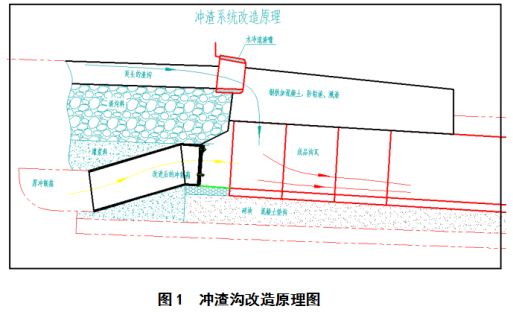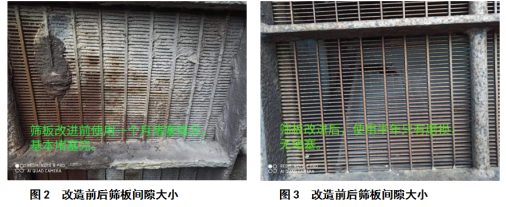15358968703

Practice of revamping 1780m3 blast furnace slag system at Dagang
Abstract: at the end of 2018, Dagang started smelting vanadium titanium magnetite at 1780m3. The comprehensive furnace grade decreased, the slag iron ratio increased, the slag viscosity was high, and the vitrification rate was low. It was easy to bond into blocks at the edge of the nozzle and slag ditch, resulting in the accumulation and blockage of the slag gully, resulting in the pressure stop of the dehydrator, the poor water filtering effect of the dehydrator, causing the slag to flow back to the tail of the belt conveyor, and the pressure stop of the belt, etc. The slag system has caused the blast furnace to be forced to plug and the sewage to flow into the river. By designing the structure of the punching box, increasing the slope of the slag ditch, using the copper sleeve water-cooled slag nozzle, increasing the clearance of the outer sieve plate of the dehydrator, optimizing the sealing device at the tail of the belt conveyor, optimizing the design of the cleaning nozzle at the head of the belt conveyor and adding a blowdown valve, the bottleneck of the slag system on the production of the blast furnace has been completely broken through.
Key words: vanadium titanium ore smelting slag system water-cooled nozzle dehydrator
1. Introduction
At the end of 2018, according to the business philosophy of "developing both steel and vanadium" of the group company, the vanadium titanium ratio of blast furnace is required to be increased to 50%; Under high V / Ti ratio smelting, the furnace temperature range of the blast furnace is narrow, the slag viscosity is large, and the vitrification rate is low. It is easy to bond into blocks at the edge of the nozzle and slag ditch, resulting in accumulation and blockage at the slag gully or the fence of the steam tower, or causing water turnover, slag, or the collapse of the Peng slag, resulting in the pressure stop of the dehydrator, and then causing the forced plugging of the blast furnace, unplanned wind shutdown, sewage into the river and other serious consequences; At the same time, part of the molten iron will be wrapped in the red slag and then enter the slag treatment system, forming iron in the slag. This part of iron will be quenched with the red slag, and finally become small iron beads dispersed in the water slag. The separation effect of slag and iron is poor. Some iron beads jam the sieve plate of the dehydrator, resulting in poor water filtering effect of the dehydrator. A large amount of water enters the slag conveying belt. Due to the large amount of water in the slag, the slag flows back to the tail of the belt conveyor, and the belt is stopped. In order to solve the impact of slag system on blast furnace, our plant will optimize and transform the West slag gully and slag treatment system during the annual overhaul of blast furnace on April 5th, 2019.
2. Transformation measures
The design of the slag gully is very long and the slope is gentle. The slag gully is easy to be blocked. The previous method is to divert water into the dry slag pool, which can basically maintain normal production. Since the smelting of vanadium titanium ore, the daily output of blast furnace has increased by 5000t ~ 5200t. As the ratio of vanadium to titanium in the furnace has increased to 50%, the comprehensive grade in the furnace has decreased to 54%, and the slag ratio has reached 450kg/t, 2300t slag is produced every day. The method of diversion is simply unrealistic and can not meet the production, but increases the cost. In order to solve the problem that the slag system restricts production and affects cost, we take the following measures:
2.1 technical measures for optimizing the slag gully
2.1.1 increase the slope of the gully
Replace 15m in the front section of the slag gully with finished ditch tiles, increase the slope of the slag gully, and increase the flushing force; In the middle and rear section, especially at the intersection with the east primary system, remove unnecessary beams to improve the cross-sectional area and make the water flow more unobstructed; Remove the nonstandard ceramic wear-resistant materials manually laid before, make special molds and weave reinforcing mesh on the parent body, and then pour and repair the damaged slag ditch as a whole to ensure the smoothness and flatness after slag washing; After the implementation, the slag is not easy to accumulate and bond, so as to reduce the formation of block slag and Peng slag, and reduce the pressure stop phenomenon of the dehydrator. Figure 1 is the schematic diagram of the reconstruction of the slag gully.
2.1.2 water cooling slag nozzle in design
Generally, refractory materials are used for pouring the slag nozzle of the slag flushing ditch, which has short service life and long pouring time. It can be completed only by continuous tapping at the iron port on the other side. Using the same type of iron and steel plants for reference, water-cooled slag flow nozzles are used, but the transformation and maintenance costs are more expensive. After discussion by the engineering and technical personnel, it was decided to use the old middle sleeve of the original small blast furnace to transform into a "soil" water-cooled slag nozzle, which was designed and manufactured offline, and used the ditch making opportunity to transform the upper line. The new slag nozzle made the slag flow pattern more regular and consistent with the water spray, and readjusted the slag flow pattern and forward inclination angle, so that the front end of the nozzle was not easy to stick and agglomerate.
2.1.3 optimize the design of punching box structure and height
Redesign the structure of the punching box and increase the water spray height as a whole to reduce the formation of lumpy slag or Peng slag at the edge of the slag ditch. The new punching box makes the punching plate easy to replace, the water outlet is evenly distributed and the angle is accurate; After the height of the punching box is raised, the impact force of the slag flow in contact with the water is reduced, the water quenching punching effect is better, the vitrification rate is improved, and the phenomenon of forming block slag or tarpaulin slag at the edge of the slag ditch is reduced, so as to reduce the accumulation and blockage at the slag ditch or the fence of the steam tower, and the pressure stop of the dehydrator naturally decreases or does not occur.

2.1.4 optimize the design of steam tower fence clearance
By collecting the large slag of steam tower for many times and measuring the size, the fence gap is redesigned to be about 20mm, which can not only block the large slag, but also pass through the general slag. Blocking the large slag is to avoid blocking the channel in the steam tower. Through the general block slag, it is to prevent a large amount of slag accumulation and canopy collapse, which will cause the pressure stop of the dehydrator; At the same time, a flushing nozzle is added at the fence of the steam tower to effectively impact and dissolve the blocked large slag; After the implementation, the phenomenon of turning over water and stopping the dehydrator with a large amount of water and slag after collapse caused by blocking of block slag and Peng material in the steam tower has been eliminated.
2.2 technical measures for improving water filtration of dehydrator
2.2.1 optimize the outer sieve plate clearance of the dehydrator
During vanadium and titanium smelting of blast furnace, the iron content in slag is 2.5 ~ 4.5%. A large number of small iron beads enter the screen plate gap behind the dehydrator, and over time, they are mixed and hardened with the glass fiber in the slag, completely blocking the screen plate, resulting in poor water filtering effect of the dehydrator; According to the daily cleaning of the sieve plate and the measurement of the iron bead diameter (basically less than 2.5mm), as well as consulting the advanced experience of other iron and steel plants and dehydrator manufacturers, the outer sieve plate gap was increased from 1.5mm in the original design to 2.5mm, so as to reduce the iron bead blocking of the sieve plate, prolong the service life of the sieve plate and improve the water filtering effect of the sieve plate. Figure 2 and figure 3 show the size of the sieve plate gap before and after the transformation.

2.2.2 reduce nozzle aperture and increase water spray pressure
By improving the size of nozzle aperture, reducing the flushing water volume, ensuring that the flushing pressure and water volume are balanced, the original design water spraying flushing pressure is increased from 2 ~ 2.5bar to 5 ~ 8bar, timely flushing the slag stuck on the sieve plate, keeping the sieve plate clean, and improving the water filtering effect of the dehydrator.
2.3 sealing device and flushing device shall be added at the tail of belt conveyor
According to the daily spot inspection, it is found that there is a large amount of slag and water flowing out from the tail of the belt conveyor, and there will be slag accumulation in each furnace of iron. If the slag is discharged for a long time, the water slag at the tail of the conveyor will accumulate more and more, and even affect the operation of the equipment. By adding a sealing stop device at the tail of the belt conveyor for slag transportation, the seal is tight. At the same time, the booster pump of the slag pool is used to make a flushing device at the tail of the conveyor. The nozzle of the flushing facility is aligned with the tail of the belt conveyor. If there is accumulated slag, immediately start the water pump to disperse the accumulated slag and return it to the slag pool, so as to eliminate the accident that the belt is stopped due to the accumulated slag at the tail of the conveyor.
3. Purpose and benefit
3.1 purpose
(1) From november2018 to march2019, the dehydrator or slag conveying belt shall be stopped once a month; After the transformation, the dehydrator or slag conveying belt has been stopped for 0 times in total since April 2019, and the frequency of pressure stop has been reduced from 1 time / month to 0 time / month.
(2) The on-time rate of tapping is improved, forced plugging is eliminated, and the impact of unclean slag iron on furnace conditions and hearth is reduced, creating strong conditions for stable and high production of No. 5 blast furnace.
(3) The waste flushing ditch and the water turning over of the dehydrator were eliminated, the sewage was not discharged into the river, the negative impact on Dagang was reduced, and Dagang was highly praised by the municipal Party committee, the municipal government and the surrounding people.
3.2 benefits
(1) The annual cost of waste residue transfer by vehicles will be reduced by about 120000 yuan.
(2) The water-cooled slag nozzle operates well. Annual refractory cost saved 4t*2000 yuan /t*december =96000 yuan / year.
(3) The service life of the outer sieve plate is increased from February to April, and the annual cost saved is 52 pieces *2400 yuan / piece *3 times =374400 yuan / year.
(4) To sum up, the total benefit created is 590400 yuan / year.